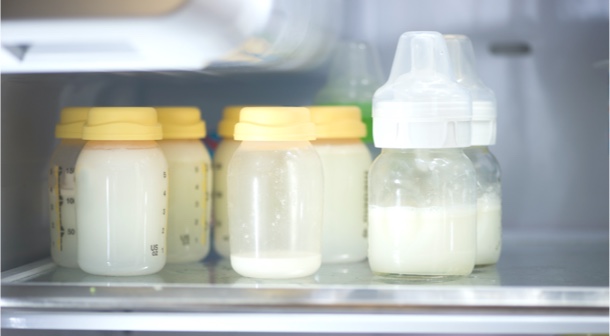Breastfeeding: You've Got This, Mom!
By Tracy Erickson, RD, IBCLC, RLC
Read Time: 8 Minutes
Congratulations on your new baby! Welcoming a little one can be exciting and exhausting, all at the same time. Whether you choose to breastfeed exclusively or not, know that every ounce of breastmilk you give your baby is a wonderful gift that helps with his (or her) growth and development.
Breastfeeding helps babies
Breastmilk provides babies with much more than nutrition. So, every time you breastfeed, you're increasing the benefits your baby receives. Mom's first milk, colostrum, is often called "liquid gold" because of all of its health benefits. It not only provides nutrients, but also powerful antibodies that keep baby from getting sick - it's like your baby's first immunization. Breastfed babies get sick less often, and they have fewer ear and respiratory infections. They are less likely to get colds or the flu, and breastfed babies have a 36% lower risk of Sudden Infant Death Syndrome (SIDS). And as they grow, breastfeeding protects babies against childhood leukemia as well as diabetes, obesity, and hypertension.
Your body makes your breastmilk just for your baby - and your breastmilk actually adjusts over time to meet your baby's changing needs. It changes from the beginning of the feeding to the end, and changes over time as your baby gets older. The proteins in breastmilk are easier on babies' stomachs, so babies are less likely to have digestive problems like gas, constipation, or colic.
Breastfeeding has also been shown to make babies smarter. Breastfed babies have higher IQs and do better in school.
Benefits for moms
Breastfeeding isn't just good for babies - it's good for moms, too. Nursing releases hormones that help you feel relaxed and bond with your baby, and it helps you get more sleep when you don't have to prepare or warm bottles. There are other ways breastfeeding helps you stay healthy - breastfeeding actually lowers a woman's risk of breast and ovarian cancer, heart disease, and diabetes. Breastfeeding is like a workout - breastfeeding burns up to 600 calories a day and causes contractions that shrink your uterus to pre-pregnancy size - so breastfeeding moms tend to recover faster.
And then there's the money. Breastfeeding for one month can save between $75 and $200 on formula costs, not including the cost of bottles and nipples. Over a year, that can add up to a savings of between $900 and $2,160.
Dad's role
As you and your partner adjust to your new roles as parents, there is a lot that fathers can do to have a positive impact on breastfeeding. Supportive fathers or other partners can help moms to breastfeed longer, which gives more health benefits to both mom and baby.

As a father or partner, you can be a strong advocate for mom and baby getting to breastfeed and having skin-to-skin time during the first hour after baby's birth, called the Sacred Hour. This is an important time for your baby to get nutrient-rich colostrum and get breastfeeding off to a good start. Even babies delivered by a cesarean (c-section) can and should have skin-to-skin time. And skin-to-skin time isn't just for moms - it's for partners too. Get lots of skin-to-skin time where you cuddle your baby on your bare chest.
While mom is recovering, you can help spot baby's early hunger cues such as lip-smacking, nuzzling or searching for the breast, moving hands to mouth, or making sucking motions. It's easier to get babies to latch when they are first showing these signs.
Of course, your most important job is to be mom's cheerleader and protector. You can provide lots of encouragement and help make sure that mom and baby have plenty of private time to breastfeed and rest. You can manage the flow of visitors and hold baby after feedings so mom can rest. Great job!
Building your milk supply
Lots of moms worry that their bodies won't make enough milk to feed their baby, but if you breastfeed every time your baby is hungry it should increase milk supply. Breastfeeding works on supply and demand, so the more you breastfeed, the more milk your body will make.
- Breastfeed in the first hour. Breastfeeding or hand-expressing colostrum in the first hour after your baby is born tells your body to start making milk.
- Follow baby's lead. Watch for early hunger cues and nurse your baby whenever he seems hungry, even if he has eaten recently. It's normal for babies to go through periods where they want to eat several times in an hour - this is called "cluster feeding."
- Offer baby both breasts at each feeding. Make sure baby is nursing efficiently and fully emptying each breast. Switching the side you offer first from one feeding to the next may help you make more milk.
- Avoid bottles and pacifiers. If baby is sucking on a pacifier, you might miss early hunger cues or a chance to feed your baby and increase milk supply.
- Get breastfeeding support. If you're having pain or trouble breastfeeding, don't suffer. There are lots of free and low-cost resources available to help, from lactation consultants and peer counselors to free breastfeeding support from your local Texas WIC clinic.
- If breastfeeding doesn't work for you, don't be hard on yourself. You don't have to breastfeed to be a great mom!

Breastfeeding in public
Babies should eat whenever they are hungry, and sometimes that might be when you're out and about. Many new moms are nervous about breastfeeding in public, but the truth is, most people won't even notice. And even if they do, Texas law says moms have the right to feed their babies anyplace, anytime. There's even a card you can download that explains your rights.
If you know you're going out, plan ahead and wear something that makes it easy to access your breasts, such as a button-down shirt you can open or a loose shirt you can pull up or down. Look for comfortable clothes that are easy to adjust. You can be as private as you want. You don't have to cover yourself, but moms who want more privacy can wear their baby in a sling or drape a blanket loosely over their shoulder.
When you're ready to feed your baby, you can sit wherever you feel most comfortable. Many stores have designated places moms can go to breastfeed or change their babies. Know that it might take some practice, but don't give up. The first time you are breastfeeding in public might feel a little awkward, but try to focus on your baby's face instead of people around you. You've got this! As the feeding gets going, you'll relax and be able to breastfeed more easily. If you're nervous, practicing at home in front of a mirror can help build your confidence.
Need parenting help now?
The Texas Parent Helpline is available 24/7.
- Call 833-680-0611
- Chat with us
- Text 833-680-0611
Pumping and Storing Milk
Once your milk supply is set, you can start pumping to build up a supply of extra milk. This will be helpful to have as you prepare to go back to work or spend time away from your baby. For the first week or so, pump once a day with an electric breast pump. Try to pump around the same time each day. Start by pumping both breasts at once on a low suction setting and increase the suction once your milk starts flowing. Massaging your breasts with your hands can help get the milk out. Many moms find they get more milk if they pump in the mornings. Pumping next to your baby or thinking about him can help your milk flow.
Cool the milk as quickly as possible. Try to store breastmilk in the amount baby eats at each feeding, likely 2-4 ounces. You can store breastmilk in sterile bags in the freezer, or in plastic or glass containers with screw-on lids. Don't forget to label the containers with the date the milk was pumped so you can use the oldest milk first.
Don't worry about color variations. It's normal for breastmilk to look white, blue, yellow, pink, or brownish, depending on what you've been eating. Also, don't worry if the milk separates once it's in the fridge - the fatty part of the milk naturally rises to the top and will need to be gently shaken to blend it prior to feedings.
Pumping shouldn't hurt. If you feel pain, call your health care provider or a lactation consultant for help and breastfeeding support.

Going back to work
Going back to work doesn't mean you have to stop breastfeeding. Making a plan and preparing for the transition will make things easier on you and your baby. Know that those first days back are the hardest, and it will get easier with time.
The first step is talking to your employer. Contact your boss ahead of time to make a plan. Let her or him know you are breastfeeding and will need a private place to pump milk. The law says employers must give moms a private place to pump and let them pump as often as they need. You can also remind your boss that breastfed babies get sick less often, which will mean you'll miss less work.
Many moms like to feed their babies right when they drop them off with a caretaker and right when they pick them up. While you're away from your baby, you'll need to pump once for each feeding time. Most moms pump once mid-morning, at lunch, and once in the afternoon. Try not to miss any pump times, because this can affect your milk supply. After pumping, store the pumped breastmilk in a fridge or in a small cooler with ice packs.
Before you go back to work, you might want to have your partner or a friend practice giving your baby a bottle of pumped milk from your milk supply. Once you're back at work, just do your best. On weekends and days off, feed your baby as often as he wants. Follow baby's hunger cues and feed on demand. This helps keep up your milk supply. Some moms have to supplement with formula, which is okay. Any amount of breastmilk helps to build a baby's immunities.
Asking for help
During these early months, balancing it all can be really hard. Be kind to yourself, and don't forget to take care of yourself. Breastfeeding support and self-care are key to your well-being.

Rest when you can. When your baby sleeps, you should try to sleep as well. Even a 90-minute nap can help you feel more rested. Give yourself a break and focus on yourself and your family during this special time. You can also rely on friends and family. This is the time to call on all of those folks who have offered to help with things! Let them stop at the grocery store, fold a load of laundry, or watch your older children.
Keep up the good work and know that you're not alone - lots of other moms are going through the same thing. It can be really reassuring to talk to other moms who have babies the same age as yours. Moms' groups are a great way to connect with other moms. Do the best you can and remember that every ounce of breastmilk counts, so give your baby what you can and enjoy your time as a new mom.





